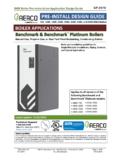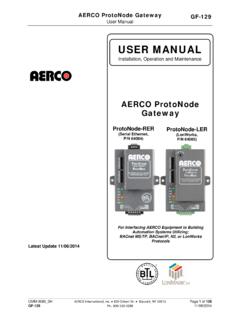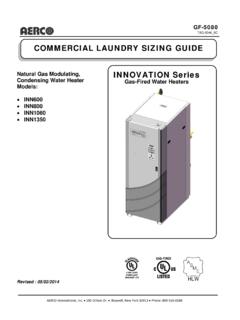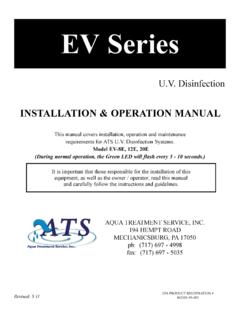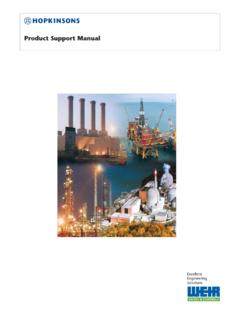Transcription of Laundry Hot Water Systems - AERCO
1 TECHNICAL. BULLETIN. HE-2020. Laundry Hot Water Systems Commercial/Institutional Applications using Helitherm Heat Exchangers AERCO INTERNATIONAL, INC. 159 PARIS AVE., NORTHVALE, NJ 07647. (201) 768-2400 FAX (201) 784-8073. THE AERCO STANDARD Laundry HOT Water system . AERCO TECHNICAL BULLETIN HE-2020 PAGE 1. The AERCO standard system generally recommended for commercial/institutional laundries is illustrated in Figure 1. Inasmuch as laundries are subjected to periodic surge flows, supplementary storage is usually required to reduce rate of change of boiler load to and acceptable level and reduce peak demand for energy by integrating the energy demand over a longer period of time. This achieves a more stable boiler (energy source) operation and permits better performance of automatic boiler control equipment. 3 to 8% improvement in boiler efficiency is not uncommon as a result of stabilizing boiler operation by keeping the rate of change of boiler load within acceptable limits.
2 system design is based upon an unrestricted energy source since the boiler equipment is assumed to have the capacity to meet the total energy requirements of the Laundry as well as other services. The system design objectives are: 1. To maintain the rate of change of boiler load within acceptable limits. 2. To lower peak boiler demand. 3. To minimize system storage and consequent energy loses. The system illustrated in figure 1 accomplishes these objectives with the following advantages: 1. Lowest operating cost. 2. Least space requirement. 3. Maximum energy savings, both in terms of fuel consumed and radiation losses minimized. PRINCIPAL OF OPERATION. BTUs are stored in the accumulator on a constant volume variable temperature basis, , the system depends on the mixing of cold and hot eater in the accumulator. The discharge from the system is taken from the outlet of the AERCO heater and not from the accumulator. With this arrangement, the heater acts as a pre-heater during periods of no or low demand and a booster heater during periods of high demand.
3 The tank serves as a fly wheel storing energy to meet the next surge flow demand, while the recirculating pump acts as a governor of the heat input rate. Sizing and selecting, the system components are relatively simple, and are covered in the following explanation and example. With properly sized components, the system set-up consists simply of setting the system final outlet temperature and adjusting on balancing cock to set the circulating pump to operate at the correct point on its curve. DETERMINATION OF Laundry HOT Water REQUIREMENTS AVERAGE. HOURLY HOT Water RATE (AHHWR) Any system Commercial Laundry equipment generally uses 2 gallons of 180 F Water per pound of cloths or linens washed. This figure is recommended by most machine manufacturers. Most heavy work requires a nominal 1 hour wash cycle, inclusive of loading and unloading the machine, and is based on a 50-60 second fill time. The use of the shorter 30. second fill time will shorten the total cycle only 3 to 4 minutes.
4 PAGE 2 AERCO TECHNICAL BULLETIN HE-2020. SEQUENCE OF OPERATION. Cold Water enters the bottom side of the inlet or the accumulator. Preheated Water is drawn from the accumulator, thence through the AERCO heater where it is heated to the set temperature, and passes to the Laundry machines. When there is not demand, Water from the top of the accumulator is passes through the heater and back to the bottom of the accumulator at a high flow rate. The circulator is selected to turn over the accumulator in approximately three minutes and with sufficient total discharge head (usually about 20 ft) to overcome the resistance of the piping and heater. The circulator flow rate is set by adjusting the balancing cock until the desired rate is being maintained and the pump is operating at the correct point on its curve. If there is cold Water in the bottom of the accumulator, the heater Water mixes with the cold Water to produce a relatively uniform temperature throughout.
5 When a demand is placed on the system , the Water from the top of the accumulator passes through the heater, bringing its temperature to the set point before flowing to the machines. The increased total flow causes an increase in the pressure drop across the balancing cock and heater, thereby causing a reduced recirculation rate and allowing more heat to be transferred to the Water to the machines. House recirculation, when provided, is fed to the discharge of the system circulator and into the accumulator. An expansion tank in the system is required when insufficient expansion capacity is provided elsewhere. The total expansion capacity required is equal to the expansion of the Water in the accumulator when heated through the full design temperature rise of the heater. If the local codes permit elimination of the check valve in the cold Water supply, it is recommended but not required. FIGURE 1 ACCUMULATOR system FOR MINIMUM STORAGE MODERATE ENERGY INPUT.
6 AERCO TECHNICAL BULLETIN HE-2020 PAGE 3. The shorter cycles often now in more common usage are not shorter because of shorter fill time, but, instead, are achieved by the elimination of a suds- or rinse-cycle or both. These are generally employed with synthetic fabrics which also use lower Water temperatures. Thus, the figure of 2 gallons/pound of fabrics being washed can be considered to be 2. gallons/pound of machine capacity for the determination of Average Hourly Hot Water Rate (AHHWR). If a 30 second fill time is standard for the entire Laundry operation, this figure might be increased 6 to 7% to gallons/pound of machine capacity. However, the figures used herein are conservative enough to preclude this necessity. Average Hourly Hot Water Rate (AHHWR) = (2) (total machine capacity in pounds). SIZING THE AERCO HELITHERM HEAT EXCHANGER (Standard system ). Since the objective of the AERCO standard system is to introduce into the system the smallest effective storage that will provide an acceptable rate of change of load of the boiler (heat source), the heater recovery rate (instantaneous capacity) must exceed the AHHWR by some amount.
7 Commercial Laundry machines use approximately of their hourly hot Water consumption in 20 minutes or of an hour. It is necessary for the heater to be able to produce twice the AHHWR through the full temperature rise. Experience has shown that this will satisfactorily meet the foregoing objective. A larger heater is unnecessary, but would not be detrimental to the system performance. It would simply provide additional sub-cooling surface. Therefore: 2 AHHWR. Heater capacity (recovery rate) in GPM =. 60 min. 4 GPM total machine capacity in pounds OR =. 60 minutes Laundry Water is required to be heated to 180 F. A proper heart selection can be made from the capacity tables furnished by AERCO using the approximate full temperature rise for the application for which it is to be used. SIZING THE ACCUMULATOR (Standard system ). Is it important that the minimum effective accumulator size be established since any selection less than this could result in the system being depleted of heated Water , not just in a minor degradation of the final outlet temperature.
8 It must have sufficient capacity to satisfy the longest sustained surge flow without additional heat input to the system . This worst case condition is unlikely, but it could occur if all machines were filled exactly sequentially or all simultaneously. Thus the accumulator capacity should equal the sum total gallons required to fill all machines to their high fill level following an intermediate extraction. The gallons required to reach high fill level and gallons required for re-saturation for machines of a given size variables only slightly from one machine manufacturer to another. If the true data is available, use it. If not, the following figures are generally accepted averages which will satisfy nearly all situations. PAGE 4 AERCO TECHNICAL BULLETIN HE-2020. 1. To reach high fill level = gallons/pound of machine capacity 2. To re-saturate = gallons/pound of machine capacity Total = gallons/pound of machine capacity Therefore: Accumulator size gallons total machine capacity in pounds CIRCULATOR CAPACITY (Standard system ).
9 The circulator should be capable of completely circulating the contents of the accumulator through the heater in approximately 3 minutes (3 minutes being the minimum time lapse between successive fills as called for by the machine program). Accumulator capacity in gallons Circulator capacity in GPM =. 3 minutes OR. Circulator capacity in GPM = = total machine capacity in pounds 3. DETERMINATION OF MAXIMUM INSTANEOUS DEMAND (MID). The nominal machine cycle of 45 to 50 minutes exclusive of loading and unloading is generally based on a 50 to 60 second time to fill to high fill level. Many machine manufactures are currently recommending a 30 second time to fill to high fill level. While fill time has no impact on accumulator and circulator sizes, and none on heater capacity, it does impact line sizes and dictates the maximum surge flow through the heater shell which must be accommodated. Therefore, it is essential to be able to determine this flow for various fill times and to be certain the heater is provided as may be necessary with properly sized bypass and/or inlet and outlet connections (side flange connections may be required) to accommodate this flow without excessive velocities.
10 The factors used in the following examples are machine manufactures' recommended factors to account for diversity resulting from a varying number of machines and variations in machine sizes. 2-minute fill time 1 or 2 machines: MID = capacity of largest machine in pounds 3 or more machines: MID = capacity of largest machines in pounds PLUS. total capacity of all other machines in pounds 1-minute fill time 1 or 2 machines: MID = capacity of largest machine in pounds 3 or more machines: MID = capacity of largest machines in pounds PLUS. total capacity of all other machines in pounds AERCO TECHNICAL BULLETIN HE-2020 PAGE 5. 30-second fill time 1 or 2 machines: MID = capacity of largest machine in pounds 3 or more machines: MID = capacity of largest machines in pounds PLUS. total capacity of all other machines in pounds EXAMPLE (Standard system ). A Laundry with incoming Water at 40 F in winter, Water to machines at 180 F, and steam available at 100 PSIG has the following Laundry machines: 2 with 600 pound capacity 1 with 400 pound capacity 1 with 250 pound capacity + 1 with 75 pound capacity 1925 pounds = Total Capacity Average Hourly Hot Water Rate (AHHWR).
